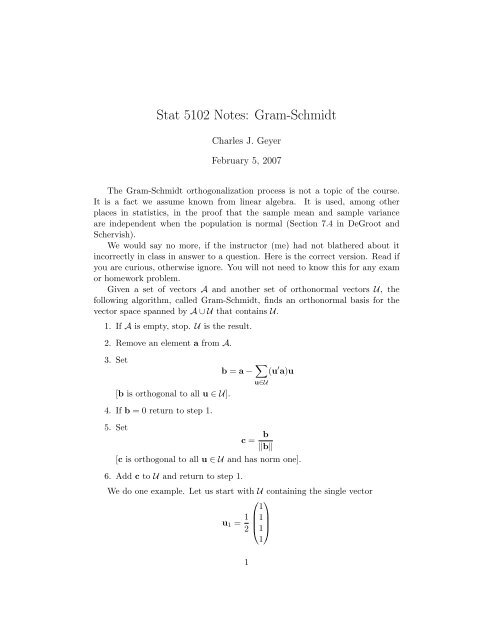Stat 5102 Notes: Gram-Schmidt
Stat 5102 Notes: Gram-Schmidt
Stat 5102 Notes: Gram-Schmidt
Create successful ePaper yourself
Turn your PDF publications into a flip-book with our unique Google optimized e-Paper software.
<strong>Stat</strong> <strong>5102</strong> <strong>Notes</strong>: <strong>Gram</strong>-<strong>Schmidt</strong><br />
Charles J. Geyer<br />
February 5, 2007<br />
The <strong>Gram</strong>-<strong>Schmidt</strong> orthogonalization process is not a topic of the course.<br />
It is a fact we assume known from linear algebra. It is used, among other<br />
places in statistics, in the proof that the sample mean and sample variance<br />
are independent when the population is normal (Section 7.4 in DeGroot and<br />
Schervish).<br />
We would say no more, if the instructor (me) had not blathered about it<br />
incorrectly in class in answer to a question. Here is the correct version. Read if<br />
you are curious, otherwise ignore. You will not need to know this for any exam<br />
or homework problem.<br />
Given a set of vectors A and another set of orthonormal vectors U, the<br />
following algorithm, called <strong>Gram</strong>-<strong>Schmidt</strong>, finds an orthonormal basis for the<br />
vector space spanned by A ∪ U that contains U.<br />
1. If A is empty, stop. U is the result.<br />
2. Remove an element a from A.<br />
3. Set<br />
[b is orthogonal to all u ∈ U].<br />
4. If b = 0 return to step 1.<br />
5. Set<br />
b = a − <br />
(u ′ a)u<br />
u∈U<br />
c = b<br />
b<br />
[c is orthogonal to all u ∈ U and has norm one].<br />
6. Add c to U and return to step 1.<br />
We do one example. Let us start with U containing the single vector<br />
u1 = 1<br />
⎛ ⎞<br />
1<br />
⎜<br />
⎜1<br />
⎟<br />
2 ⎝1⎠<br />
1<br />
1
and let A contain the four vectors that are the usual basis for four-dimensional<br />
Euclidean space<br />
⎛ ⎞<br />
1<br />
⎜<br />
a1 = ⎜0<br />
⎟<br />
⎝0⎠<br />
0<br />
, a2<br />
⎛ ⎞<br />
0<br />
⎜<br />
= ⎜1<br />
⎟<br />
⎝0⎠<br />
0<br />
, a3<br />
⎛ ⎞<br />
0<br />
⎜<br />
= ⎜0<br />
⎟<br />
⎝1⎠<br />
0<br />
, a4<br />
⎛ ⎞<br />
0<br />
⎜<br />
= ⎜0<br />
⎟<br />
⎝0⎠<br />
1<br />
.<br />
In the first iteration of <strong>Gram</strong>-<strong>Schmidt</strong> in step 2 we remove a1 from A, and<br />
in step 3 we calculate<br />
(This was the step botched in class.)<br />
In step 5 we calculate<br />
and<br />
b = a1 − (u ′ 1a1)u1<br />
⎛ ⎞ ⎡<br />
1<br />
⎛ ⎞⎤<br />
⎛ ⎞<br />
1 1<br />
⎜<br />
= ⎜0<br />
⎟<br />
1 ⎢<br />
⎝0⎠<br />
− ⎢<br />
4 ⎣ 1 1 1<br />
⎜<br />
1 ⎜0⎟⎥<br />
⎜<br />
⎟⎥<br />
⎜1<br />
⎟<br />
⎝0⎠⎦<br />
⎝1⎠<br />
0<br />
⎛ ⎞<br />
1<br />
⎛ ⎞<br />
1<br />
0 1<br />
⎜<br />
= ⎜0<br />
⎟<br />
1 ⎜<br />
⎝0⎠<br />
− ⎜1<br />
⎟<br />
4 ⎝1⎠<br />
0<br />
=<br />
1<br />
1<br />
⎛ ⎞<br />
3<br />
⎜<br />
⎜−1<br />
⎟<br />
4 ⎝−1⎠<br />
−1<br />
b 2 =<br />
2 <br />
3<br />
+ −<br />
4<br />
1<br />
2 <br />
+ −<br />
4<br />
1<br />
2 <br />
+ −<br />
4<br />
1<br />
2 4<br />
= 12<br />
16<br />
c = 1<br />
⎛ ⎞<br />
3<br />
⎜<br />
⎜−1<br />
⎟<br />
4<br />
4 ⎝−1⎠<br />
· √<br />
12<br />
−1<br />
In step 6 we add this to U, so call it<br />
u2 = 1<br />
⎛ ⎞<br />
3<br />
⎜<br />
√ ⎜−1<br />
⎟<br />
12<br />
⎝−1⎠<br />
−1<br />
2
Now we are ready for another iteration. In the second iteration of <strong>Gram</strong>-<br />
<strong>Schmidt</strong> in step 2 we remove a2 from A, and in step 3 we calculate<br />
and<br />
In step 5 we calculate<br />
b = a2 − (u ′ 1a2)u1 − (u ′ 2a2)u2<br />
⎛ ⎞ ⎡<br />
⎛ ⎞⎤<br />
⎛ ⎞<br />
0<br />
0 1<br />
⎜<br />
= ⎜1<br />
⎟<br />
1 ⎢<br />
⎝0⎠<br />
− ⎢<br />
4 ⎣ 1 1 1<br />
⎜<br />
1 ⎜1⎟⎥<br />
⎜<br />
⎟⎥<br />
⎜1<br />
⎟<br />
⎝0⎠⎦<br />
⎝1⎠<br />
0<br />
0 1<br />
− 1<br />
⎡<br />
⎛ ⎞⎤<br />
⎛ ⎞<br />
0 3<br />
⎢<br />
⎢<br />
12 ⎣ 3 −1 −1<br />
⎜<br />
−1 ⎜1⎟⎥<br />
⎜<br />
⎟⎥<br />
⎜−1<br />
⎟<br />
⎝0⎠⎦<br />
⎝−1⎠<br />
⎛ ⎞<br />
0<br />
⎛ ⎞<br />
1<br />
⎛ ⎞<br />
3<br />
0 −1<br />
⎜<br />
= ⎜1<br />
⎟<br />
1 ⎜<br />
⎝0⎠<br />
− ⎜1<br />
⎟<br />
1 ⎜<br />
4 ⎝1⎠<br />
+ ⎜−1<br />
⎟<br />
12 ⎝−1⎠<br />
0<br />
=<br />
1 −1<br />
1<br />
⎛ ⎞<br />
0<br />
⎜ 8 ⎟<br />
12 ⎝−4⎠<br />
−4<br />
b 2 = 0 2 +<br />
= 6<br />
9<br />
2 <br />
2<br />
+ −<br />
3<br />
1<br />
2 <br />
+ −<br />
3<br />
1<br />
2 3<br />
c = 1<br />
⎛ ⎞<br />
0<br />
⎜ 2 ⎟<br />
3 ⎝−1⎠<br />
−1<br />
· 3<br />
√ 6<br />
In step 6 we add this to U, so call it<br />
u3 = 1<br />
⎛ ⎞<br />
0<br />
⎜<br />
√ ⎜ 2 ⎟<br />
6<br />
⎝−1⎠<br />
−1<br />
Now we are ready for another iteration. In the third iteration of <strong>Gram</strong>-<br />
3
<strong>Schmidt</strong> in step 2 we remove a3 from A, and in step 3 we calculate<br />
and<br />
In step 5 we calculate<br />
b = a3 − (u ′ 1a3)u1 − (u ′ 2a3)u2 − (u ′ 3a3)u3<br />
⎛ ⎞ ⎡<br />
⎛ ⎞⎤<br />
⎛ ⎞<br />
0<br />
0 1<br />
⎜<br />
= ⎜0<br />
⎟<br />
1 ⎢<br />
⎝1⎠<br />
− ⎢<br />
4 ⎣ 1 1 1<br />
⎜<br />
1 ⎜0⎟⎥<br />
⎜<br />
⎟⎥<br />
⎜1<br />
⎟<br />
⎝1⎠⎦<br />
⎝1⎠<br />
0<br />
0 1<br />
− 1<br />
⎡<br />
⎛ ⎞⎤<br />
⎛ ⎞<br />
0 3<br />
⎢<br />
⎢<br />
12 ⎣ 3 −1 −1<br />
⎜<br />
−1 ⎜0⎟⎥<br />
⎜<br />
⎟⎥<br />
⎜−1<br />
⎟<br />
⎝1⎠⎦<br />
⎝−1⎠<br />
0 −1<br />
− 1<br />
⎡<br />
⎛ ⎞⎤<br />
⎛ ⎞<br />
0 0<br />
⎢<br />
⎢<br />
6 ⎣ 0 2 −1<br />
⎜<br />
−1 ⎜0⎟⎥<br />
⎜<br />
⎟⎥<br />
⎜ 2 ⎟<br />
⎝1⎠⎦<br />
⎝−1⎠<br />
⎛ ⎞<br />
0<br />
⎛ ⎞<br />
1<br />
0<br />
⎛ ⎞<br />
3<br />
−1<br />
⎛ ⎞<br />
0<br />
⎜<br />
= ⎜0<br />
⎟<br />
1 ⎜<br />
⎝1⎠<br />
− ⎜1<br />
⎟<br />
1 ⎜<br />
4 ⎝1⎠<br />
+ ⎜−1<br />
⎟<br />
1 ⎜<br />
12 ⎝−1⎠<br />
+ ⎜ 2 ⎟<br />
6 ⎝−1⎠<br />
0<br />
=<br />
1 −1 −1<br />
1<br />
⎛ ⎞<br />
0<br />
⎜<br />
⎜0<br />
⎟<br />
12 ⎝6⎠<br />
6<br />
b 2 = 0 2 + 0 2 +<br />
= 2<br />
4<br />
c = 1<br />
2<br />
In step 6 we add this to U, so call it<br />
⎛<br />
⎜<br />
⎝<br />
0<br />
0<br />
1<br />
−1<br />
u4 = 1<br />
√ 2<br />
4<br />
2 <br />
1<br />
+ −<br />
2<br />
1<br />
2 2<br />
⎞<br />
⎟<br />
⎠<br />
⎛<br />
⎜<br />
⎝<br />
· 2<br />
√ 2<br />
0<br />
0<br />
1<br />
−1<br />
⎞<br />
⎟<br />
⎠
Now we are ready for another iteration. In the fourth iteration of <strong>Gram</strong>-<br />
<strong>Schmidt</strong> in step 2 we remove a4 from A, and in step 3 we calculate<br />
b = a4 − (u ′ 1a4)u1 − (u ′ 2a4)u2 − (u ′ 3a4)u3 − (u ′ 4a4)u4<br />
⎛ ⎞ ⎡<br />
⎛ ⎞⎤<br />
⎛ ⎞<br />
0<br />
0 1<br />
⎜<br />
= ⎜0<br />
⎟<br />
1 ⎢<br />
⎝0⎠<br />
− ⎢<br />
4 ⎣ 1 1 1<br />
⎜<br />
1 ⎜0⎟⎥<br />
⎜<br />
⎟⎥<br />
⎜1<br />
⎟<br />
⎝0⎠⎦<br />
⎝1⎠<br />
1<br />
1 1<br />
− 1<br />
⎡<br />
⎛ ⎞⎤<br />
⎛ ⎞<br />
0 3<br />
⎢<br />
⎢<br />
12 ⎣ 3 −1 −1<br />
⎜<br />
−1 ⎜0⎟⎥<br />
⎜<br />
⎟⎥<br />
⎜−1<br />
⎟<br />
⎝0⎠⎦<br />
⎝−1⎠<br />
1 −1<br />
− 1<br />
⎡<br />
⎛ ⎞⎤<br />
⎛ ⎞<br />
0 0<br />
⎢<br />
⎢<br />
6 ⎣ 0 2 −1<br />
⎜<br />
−1 ⎜0⎟⎥<br />
⎜<br />
⎟⎥<br />
⎜ 2 ⎟<br />
⎝0⎠⎦<br />
⎝−1⎠<br />
1 −1<br />
− 1<br />
⎡<br />
⎛ ⎞⎤<br />
⎛ ⎞<br />
0 0<br />
⎢<br />
⎢<br />
2 ⎣ 0 0 1<br />
⎜<br />
−1 ⎜0⎟⎥<br />
⎜<br />
⎟⎥<br />
⎜ 0 ⎟<br />
⎝0⎠⎦<br />
⎝ 1 ⎠<br />
⎛ ⎞<br />
0<br />
⎛ ⎞<br />
1<br />
1<br />
⎛ ⎞<br />
3<br />
−1<br />
⎛ ⎞<br />
0<br />
⎛ ⎞<br />
0<br />
⎜<br />
= ⎜0<br />
⎟<br />
1 ⎜<br />
⎝0⎠<br />
− ⎜1<br />
⎟<br />
1 ⎜<br />
4 ⎝1⎠<br />
+ ⎜−1<br />
⎟<br />
1 ⎜<br />
12 ⎝−1⎠<br />
+ ⎜ 2 ⎟<br />
1 ⎜<br />
6 ⎝−1⎠<br />
+ ⎜ 0 ⎟<br />
2 ⎝ 1 ⎠<br />
1<br />
=<br />
1 −1 −1 −1<br />
1<br />
⎛ ⎞<br />
0<br />
⎜<br />
⎜0<br />
⎟<br />
12 ⎝0⎠<br />
0<br />
Since b is zero we go back to step 1, and since A is now empty (we have<br />
removed each of its original four elements, one in each iteration) we are done.<br />
The orthonormal basis is<br />
u1 = 1<br />
2<br />
⎛ ⎞<br />
1<br />
⎜<br />
⎜1<br />
⎟<br />
⎝1⎠<br />
1<br />
, u2 = 1<br />
⎛ ⎞<br />
3<br />
⎜<br />
√ ⎜−1<br />
⎟<br />
12<br />
⎝−1⎠<br />
−1<br />
, u3 = 1<br />
⎛ ⎞<br />
0<br />
⎜<br />
√ ⎜ 2 ⎟<br />
6<br />
⎝−1⎠<br />
−1<br />
, u4 = 1<br />
⎛ ⎞<br />
0<br />
⎜<br />
√ ⎜ 0 ⎟<br />
2<br />
⎝ 1 ⎠<br />
−1<br />
5
The matrix whose rows are these vectors<br />
⎛<br />
⎜<br />
A = ⎜<br />
⎝<br />
1 1 1 1<br />
2 2 2 2<br />
√3 12<br />
− 1 √<br />
12<br />
− 1 √<br />
12<br />
− 1 √<br />
12<br />
0 √6 2 − 1 √<br />
6<br />
− 1 √<br />
6<br />
0 0 √2 1 − 1 √<br />
2<br />
is one possibility for the A that is used in the proof if the big theorem in<br />
Section 7.4 of DeGroot and Schervish.<br />
6<br />
⎞<br />
⎟<br />
⎠

















